Sign up to our mailing list or join us to find out about the next FoSB event (including our flower walk, bird walk, beach cleans and other community events).
Red dead-nettle (Lamium purpureum)
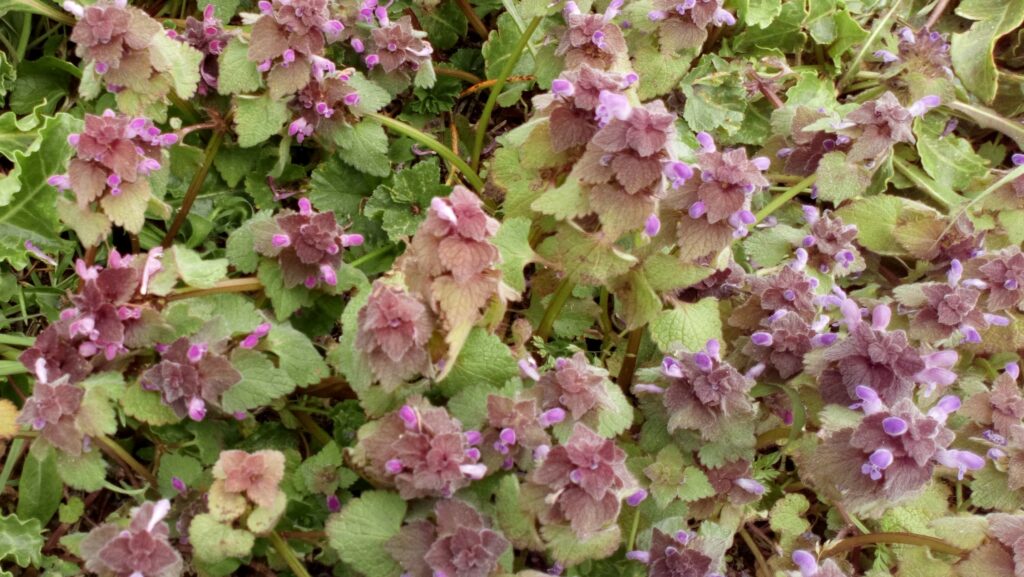
Red dead-nettle (Lamium purpureum) is a common plant of roadside verges, waste grounds and field edges – anywhere the ground has been disturbed or cultivated.
So it grows on the Reserve near the house at the Eastern end. Like other members of the dead-nettle family, it doesn’t have stinging leaves. Its crimson flowers appear from March to October.
Many different species of long-tongued insects visit the flowers, including the red mason bee and bumblebees. The caterpillars of garden tiger, white ermine and angle shades moths feed on the leaves. It has been called the bumble bee flower.
The generic name is from the Greek lamia meaning ‘devouring monster’. This refers to the helmet shape (galeate) of the flower which has the appearance of open jaws. It is likely that this plant was introduced to Britain with early agriculture and evidence for it has been found in Bronze Age deposits.
In terms of traditional medicinal uses, dried leaves have been used as a poultice to stem hemorrhaging whilst fresh bruised leaves have been applied to external wounds and cuts. The leaves have been used as a diuretic and to promote perspiration.
Plants should never be taken from our Local Nature Reserve and if you are not trained you should not pick wild flowers to eat or use for medicinal purposes as many plants can be poisonous.
Rock Samphire (Crithmum maritimum)
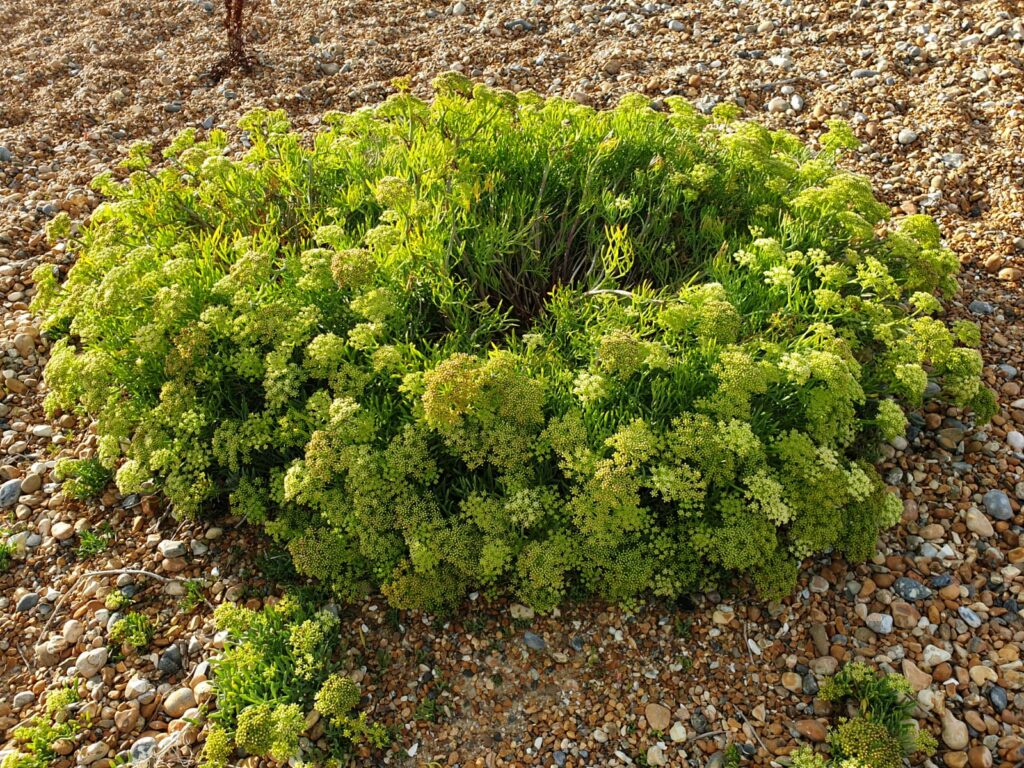
Rock Samphire (Crithmum maritimum) is a member of the Apiaceae (Previously the Umbelliferae) family. It is in flower from June to August, and the seeds ripen from August to October.
It is also known as Sea Fennel or True Samphire. It is a salt tolerant coastal plant found on shingle beaches and rocky cliffs. The species is hermaphrodite (has both male and female organs) and is pollinated by insects. The plant is self-fertile. It can be grown in gardens in well drained soils. For centuries, Rock Samphire was food for the poor, free to those who picked it, usually ordinary people living by the sea. It has been eaten since ancient times in the UK, and was very popular pickled in the 16th century. It is ironic that today it is regarded as a specialty food and is often served with an accompanying price tag. It is supposed to taste a bit like asparagus but I have found it a slightly bitter (Not taken from the LNR but eaten in the coastal west of the UK!)
Plants should never be taken from our Local Nature Reserve and if you are not trained you should not pick wild flowers to eat or use for medicinal purposes as many plants can be poisonous.s
Red Valerian (Centranthus ruber)
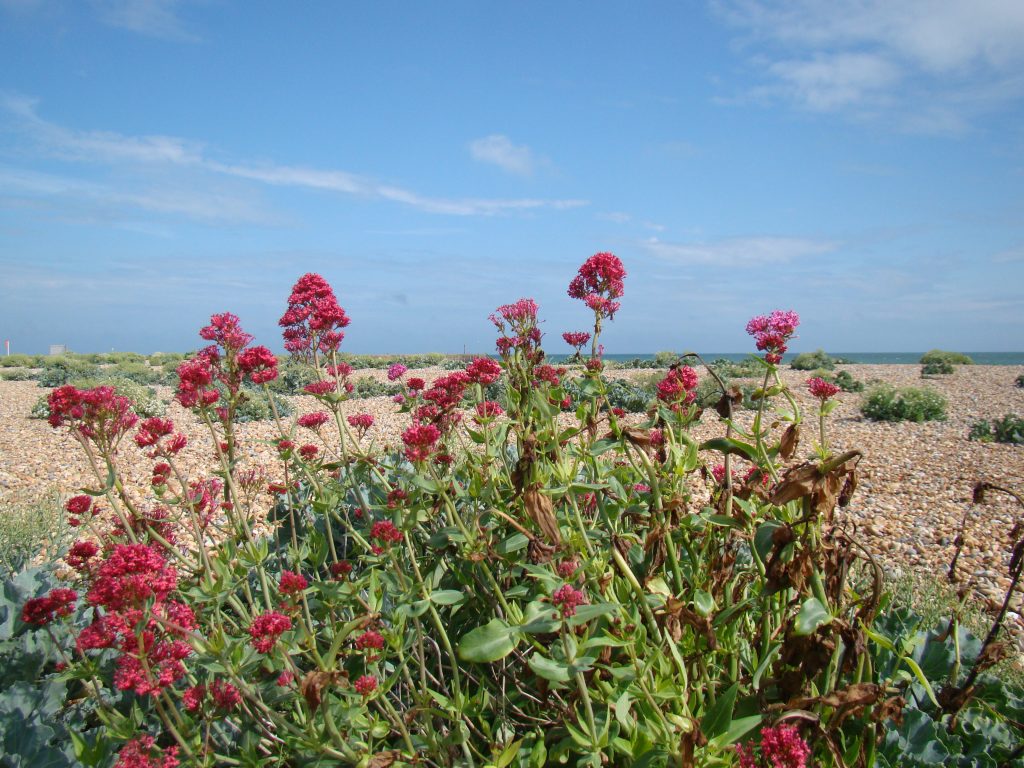
Red Valerian (Centranthus ruber) also called spur valerian, kiss-me-quick, fox’s brush, devil’s beard and Jupiter’s beard, is a popular perennial garden plant grown for its ornamental flowers which are red, pink or white.
It adapts to soils that are poor, alkaline, moist or dry, sandy or chalky. It flowers from April through to October. Bees and butterflies use the plant. It is not native but a naturalised neophyte i.e. it came into the country after 1500.
It has escaped from gardens and is regarded as invasive on the Local Nature Reserve because it takes up space where specialised shingle plants should grow. We try to reduce it and stop it from spreading further.
It has very long tap roots which are almost impossible to get out. We remove seedlings where we can. It is not the Common Valerian used as a sleeping medicine.
Plants should never be taken from our Local Nature Reserve
Sea kale (Crambe maritima)
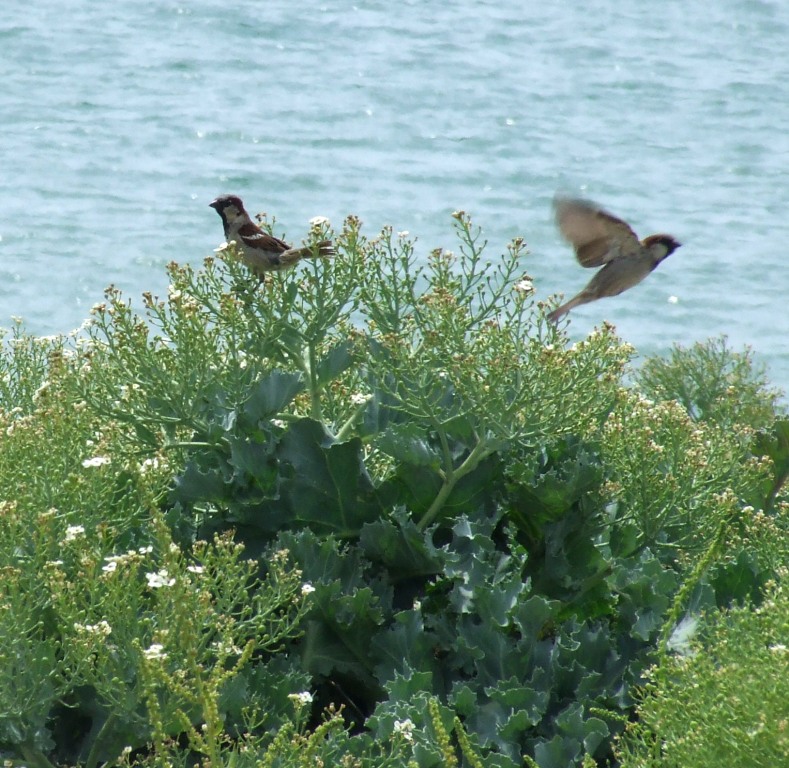
Seakale (Crambe maritima) is a dominant plant on the Reserve. It is a specialized shingle plant. It grows in the intermediate zone between the really tough Pioneer zone plants like Orache that can survive salt water and the non specialized plants that grow closer to the soil rich areas near the houses.
The large leaves are cupped to make the rain water run down to the stalk and root and are waxy, which means that the stomata are buried to reduce evaporation. It has a very long tap root that can go deep to find water.
The perfumed nectar-rich flowers are great for attracting pollinating insects. Sea kale is mentioned in some of the earliest references to food. The Romans preserved it in barrels for sea voyages. Its high vitamin C content would have prevented scurvy. Sea kale was cultivated in Europe from at least the 1600s until around World War II. Unlike potatoes and carrots, it appears to be indigenous to the UK. It can be grown in gardens. There is sometimes a problem because it is now a fashionable food and restaurateurs and others try to collect from the beach.
Plants should never be taken from our Local Nature Reserve and if you are not trained you should not pick wild flowers to eat or use for medicinal purposes as many plants can be poisonous.
Seaside Daisy (Erigeron glaucus)

Seaside Daisy (Erigeron glaucus) is a species of flowering plant in the daisy family (Asteraceae formerly Compositae) also known as Seaside fleabane, Beach aster.
This hardy, pretty plant is mainly found in coastal regions. It is said to be toxic to ruminants like cows and goats, and to molluscs, and has been traditionally used as an insect repellent.
It is an invader from the USA and is native to the coastline of Oregon and California where it grows on beaches, coastal bluffs and dunes. There is plenty on the Local Nature Reserve. It tends to spread so it is a useful covering plant in our beach gardens.
Daisy family flower heads consist of a compact mass of very tiny flowers without stalks (florets) sitting on a flattened disc. The central florets are tubular and typically the outermost circle of flowers around the edge of the disc each bears a single strap-like extension of the flower tube. This is usually coloured differently from the central flowers.
Seaside daisy is not attractive to native butterflies as native butterflies like native flowers. However, the multitude of florets and attractive colours attract many other pollinators including bees. It has such a long flowering season that, as long as the weather is not too cold, it can provide a nectar source even in the dead of winter.
Plants should never be taken from our Local Nature Reserve
Starry Clover (Trifolium stellatum)
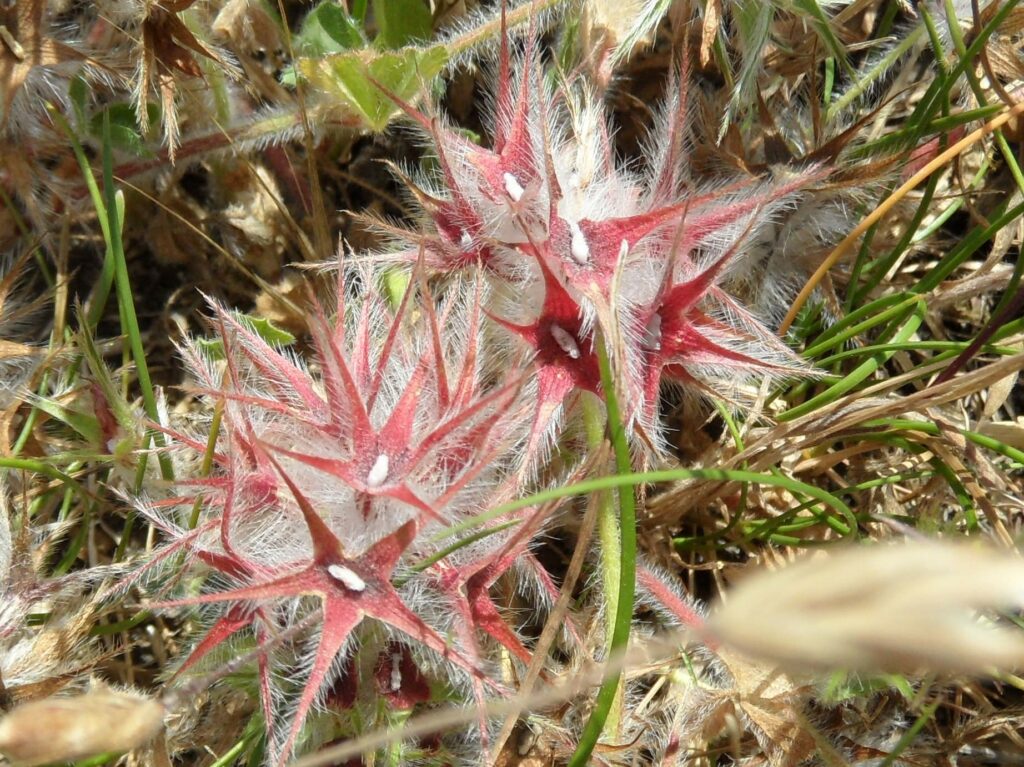
Starry Clover (Trifolium stellatum) is Shoreham Beach’s most famous flower. For at least 150 years it was the only place it grew in the UK.
It was first found on the LNR in 1804 and is thought to have come by sea in ships’ ballast from the Mediterranean where it is a common native clover. It is an annual and likes soil that is a bit disturbed.
It has grown in two places at the Shoreham Fort and in patches along the path going West along the LNR close to the houses and at the extensions of the beach at some road entrances.
Now it grows at the SSSI at Browndown in Hampshire and two places near the Widewater. It can be missing from an area for years and then reappear. The Friends of Shoreham Beach map its distribution annually.
Plants should never be taken from our Local Nature Reserve
Three-cornered Garlic (Allium triquetrum)
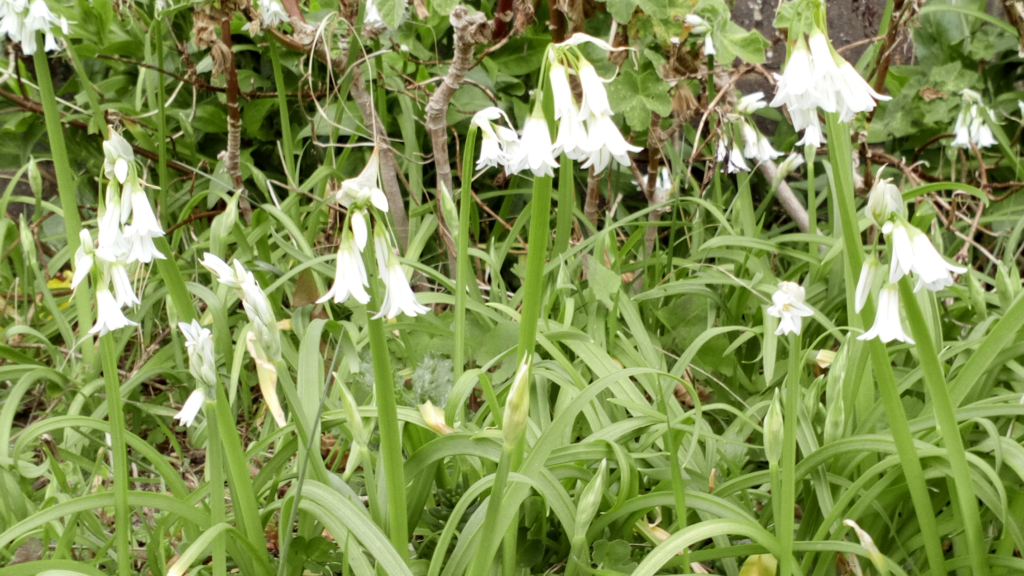
Three-cornered Garlic or Three-cornered Leek or Angled onion (Allium triquetrum) is a bulbous flowering plant in the genus Allium which includes garlics, onions and snowdrops and daffodils. It is identified by the white bell like flowers and triangular leaves and the smell of garlic.
It is native to south-western Europe, north-western Africa, Madeira and the Canary Islands. It has invaded the UK from its native countries and spreads like wildfire from seeds and bulbs quickly choking out gentler plants.
The flowers attract pollinators keeping them from native plants. It is nearly impossible to get rid of especially as dormant bulbs can remain in the soil for up to six years.
It has got on to the LNR and into the gardens and roadsides of Shoreham and is damaging the Shoreham Beach LNR ecosystem. It slunk in as a pretty spring flower from its native areas near the Mediterranean. Its invasive nature damaging natural habitats and ecosystems soon became apparent. Hence it is classified as a noxious weed as under the Wildlife and Countryside Act 1981 Schedule 9. It is an offence to allow it to escape into the wild.
Alas too late for the Shoreham beach. It is a plant we vainly hope we can eliminate from the reserve so we remove as much as we can annually.
All parts of the plant, from the bulb to the flowers, are edible fresh (for example in pesto) or cooked.
Plants should never be taken from our Local Nature Reserve and if you are not trained you should not pick wild flowers to eat or use for medicinal purposes as many plants can be poisonous.
Thrift (Armeria maritima)
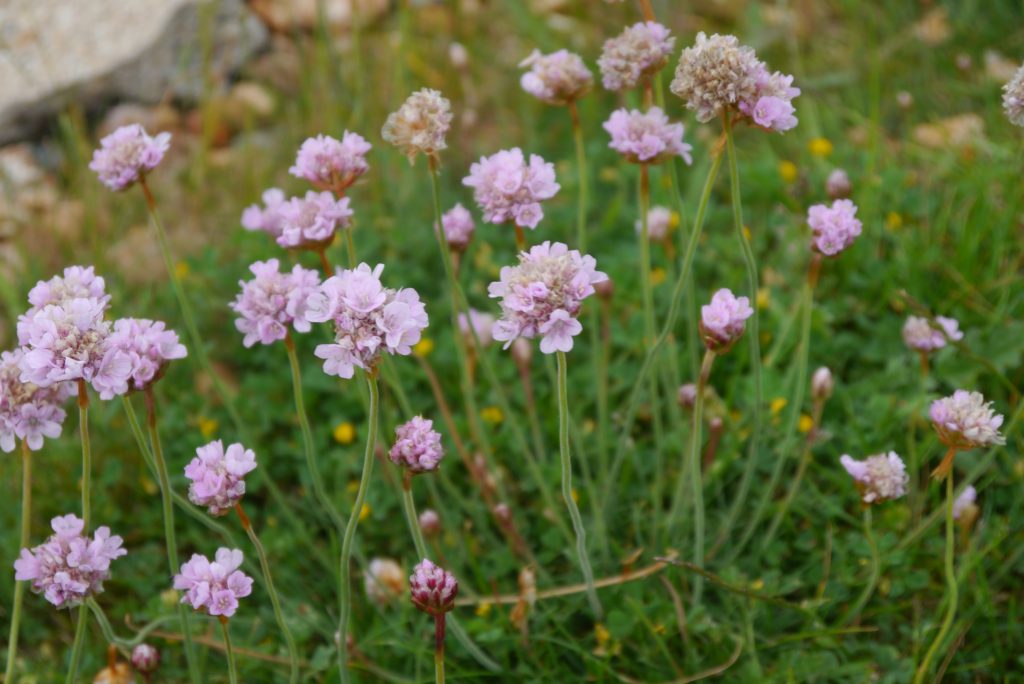
Thrift (Armeria maritima) is a member of the Plumbaginaceae family. Cushions of clover-like, pink Thrift are a familiar sight of cliffs, shingle beaches and sand dunes around the UK. It has started to appear inland on roadsides as salting creates favourable conditions
Also known as ‘Cliff Clover’, it makes a good garden plant. Pollination is by various insects including bees and Lepidoptera. Each flower has white to pink petals (RC) and are followed by papery seed heads (R).
Thrift grows best in full sun in lean, very well-drained soil. The plants are drought tolerant and do not tolerate moist soil. In Gaelic thrift is known as tonna chladaich, meaning ‘beach wave’. In Welsh it is called clustog fair, Mary’s pillow. It is also known as Sea Pink, Sea Thrift, Rock Rose and Our Ladies Cushion.
Thrift was used as an emblem on the threepenny-bit between 1937 and 1953 – the Mint no doubt aware of the double meaning in its name. It is the county flower of the Isles of Scilly. Pembokreshire and the Isle of Bute. In the Language of Flowers thrift stands for sympathy.
Plants should never be taken from our Local Nature Reserve
Tree mallow (Lavatera arborea)
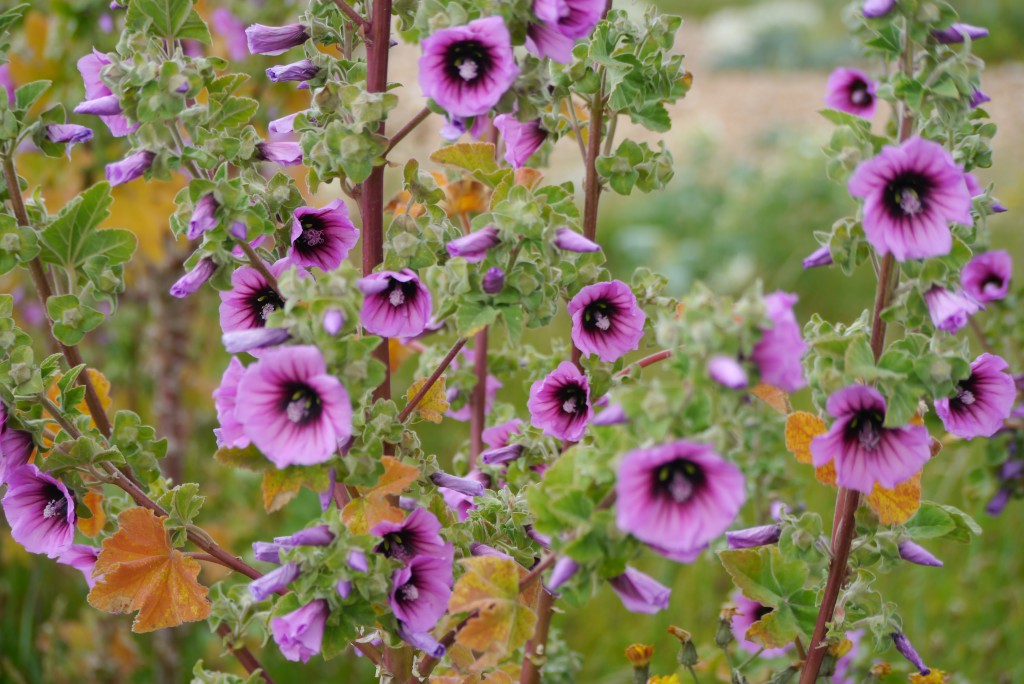
Tree mallow (Lavatera arborea) sometimes known as Malva arborea, or, more recently as Malva eriocalyx, is a species of mallow native to the British Isles south.
It tolerates sea water to varying degrees, at up to 100% sea water in its natural habitat, excreting salt through glands on its leaves. The leaves of the species are used in herbal medicine to treat sprains, by steeping them in hot water and applying the poultice to the affected area.
It is theorised that lighthouse keepers may have spread the plant to some British islands for use as a poultice and to treat burns, an occupational hazard. It is thought to have been used as an alternative to toilet paper. The seeds are edible and are known in Jersey as “petit pains”, or “little breads”.
One of Britain’s best-known seabirds, the puffin, is being forced out of a number of Scottish seabird island colonies by dense stands of tree mallow, growing up to 3 metres tall, and choking puffin breeding sites. It is feared that the plant could soon start affecting other coastal breeding birds such as cormorant, eider duck, herring gull and fulmar.
Whilst present in confined places for several hundreds of years, the plant has suddenly become invasive, taking over island ecosystems and thereby suppressing ground breeding birds and native vegetation.
This is happening on our Reserve so we are having to reduce the numbers of Tree Mallow plants to stop them crowding out the specialised plants. This is not a toxic weed so only a reduction in numbers is needed. Its flowers attract bees and butterflies and moths. So in safe quantities it is a useful plant. The reasons for this rapid expansion may be milder winters and an increase in manure rich soil. Understanding why plants can be invasive in one place whilst not in another has become essential. Experiments are underway to determine the reasons for this plant becoming invasive.
Plants should never be taken from our Local Nature Reserve and if you are not trained you should not pick wild flowers to eat or use for medicinal purposes as many plants can be poisonous.
Viper’s Bugloss (Echium vulgare)
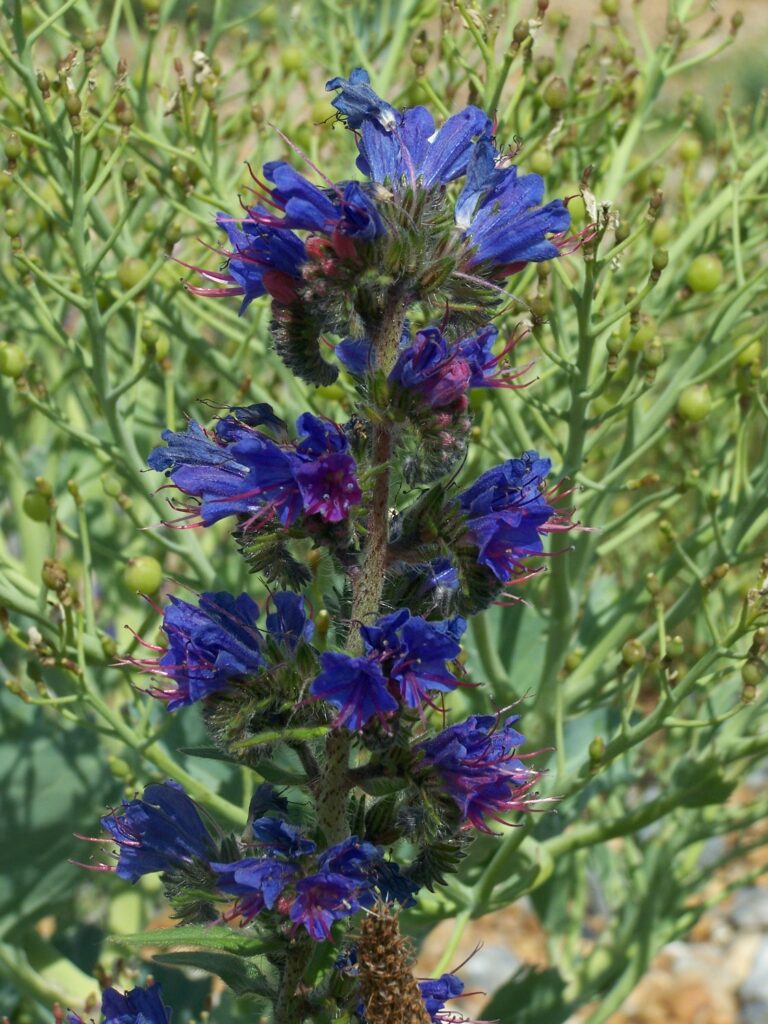
Viper’s Bugloss (Echium vulgare) is one of the top 5 best honey plants in the world. This native British biennial is a member of the Boraginaceae family. It is used by bees of many varieties, hoverflies and butterflies and caterpillars.
Its cousin Borage is also a very good plant for honey production. It is also known as blueweed, blue thistle, blue devil. It has spread well over the LNR and this is very good news for the insects that use it.
Rare caterpillars also use it. In 2013 the moth expert Tim Freed did a moth survey and found 3 nationally scarce species on the LNR using the Vipers Bugloss.
He wrote this about the rare moths: “Significantly, three of these nationally scarce moths have viper’s-bugloss Echium vulgare as their larval foodplant and all four species are largely restricted to shingle beaches in the coastal region. Tinagma ocnerostomella was recorded abundantly at Shoreham Shingles in the latter part of C19th, but apparently not since then (Pratt, 2011). Three specimens of Coleophora pennella were recorded from Shoreham Beach by THF on 13th June 2007, the only previous records for Shoreham having been made in the latter part of C19th (ibid). The record of Ethmia terminella constitutes a first for this moth in West Sussex (VC13). The species is also found on the coast at Rye and Eastbourne where it is extremely local. Dolicharthria punctalis is probably the most widespread (Sussex-wise) of these notable moths though apparently it has not been noted at Shoreham since c.1924, probably due to a lack of recording effort (ibid). A singleton of the tortricid Crocidosema plebejana was also taken. This species appears to be quite well established along the Sussex coast where tree-mallow, its larval foodplant, grows.”
Native to the UK and most of Europe, Echiums have tall spikes with many flowers. There are garden varieties and there is a marvellous display of them on the Scilly Isles. It is great to see so much flowering on the reserve.
Plants should never be taken from our Local Nature Reserve.
Yellow Horned Poppy (Glaucium flavum)
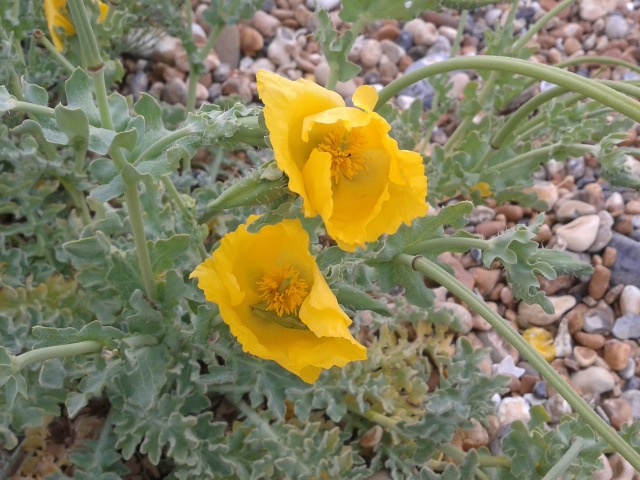
Yellow Horned Poppy (Glaucium flavum) is so-named for its long, curving seedpods that look like horns.
The flowers appear between June and October and are followed by the curling seedpods that can be up to 30cm long. It is said to be the largest seed pod of any British plant. When it is broken, the plant exudes a yellow sap which is poisonous, as is the whole plant.
It should not be eaten as it can cause brain damage and death! It is a specialised Shingle plant and can be found on sand dunes. It is never found inland.
Its adaptations include a very long tap root and thick, deeply segmented, wavy, bluish-grey hairy leaves, which are coated in a layer of water-retaining wax. They direct water to the centre of the plant. It is a short-lived perennial.
It is referenced in various poems.e.g.
A poppy grows upon the shore,
Bursts her twin cups in summer late:
Her leaves are glaucus-green and hoar,
Her petals yellow, delicate.
She has no lovers like the red,
That dances with the noble corn:
Her blossoms on the waves are shed,
Where she stands shivering and forlorn.
Robert Bridges
Plants should never be taken from our Local Nature Reserve and if you are not trained you should not pick wild flowers to eat or use for medicinal purposes as many plants can be poisonous.
You can also see more flowers on our flower gallery.